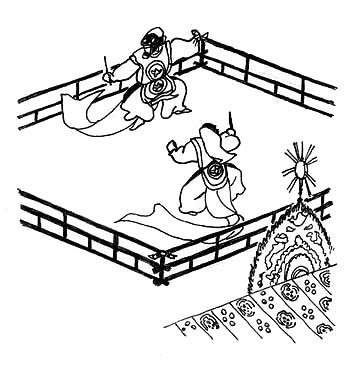|
||
 |
||

(C)2001 Japanese Architecture and Art Net Users System. No reproduction or republication without written permission.
掲載のテキスト・写真・イラストなど、全てのコンテンツの無断複製・転載を禁じます。
|
||||||
| bugaku 舞楽 | ||||||
| KEY WORD : art history / general terms | ||||||
| Imperial court dance that accompanies Imperial court dance, gagaku 雅楽, as performed from the late 8c to the present day, although somewhat confusingly, bugaku today is called gagaku. Bugaku dances and gagaku music are an amalgam of a wide variety of dances that were imported into Japan from the Asian continent and incorporated into official court functions. So official was the status of the art that a ministry of the dance, gagakuryou 雅楽寮, was set up in the Imperial Palace in 701. During the Heian period, a golden age for bugaku, in addition to official performances by the professionals in the bureau of music, bugaku was performed by amateur courtiers at many pleasurable pastimes such as Cherry Viewing and Moon Gazing parties. Also horse racing, archery contests, and football games often ended in a performance of bugaku. Bugaku dances have been divided into two groups according to their country of origin. Those imported from China tougaku 唐楽 or South East Asia rin'yuugaku 林邑楽 are known today as sa-no-mai 左舞 (Dances of the Left), and those from Mongolia bokkaigaku 渤海楽 or Korea komagaku 高麗楽 are known as u-no-mai 右舞 (Dances of the Right). The two styles of dance are performed alternately in pairs, tagaimai 互舞, with the dancers appearing from opposite sides of the square stage and the musicians being seated on the appropriate sides. Each orchestra is backed by a large drum, dadaiko 大太鼓. For Dances of the Left this drum has red cords, a bright golden sun on the top of its flaming wooden frame decorated with fiery dragons, and is placed on the left side at the back of the stage as seen from the audience. For Dances of the Right, the drum has green cords, a large silver moon atop a flaming frame decorated with a pair of phoenix birds, and is placed on the right side at the back of the stage. This color symbolism is retained in the costume of the actors, as well. The two styles of dance differ in various refinements such as the manner in which dancers mark the beats with a swing of the foot and the position of the fingers. The two styles of music use somewhat different instruments and different rhythmic systems. In some cases one dance can involve more than one pair of dancers. In addition, dances may be categorized according to their placement in a program. First come quiet, slow dances performed by four or six people dancing in unison, known as hiramai 平舞. Many of these are unmasked. Next come the more active military dances, bu-no-mai 武舞, for which the dancers are dressed in simulated armour and carry spears and swords. Finally solo dances in a faster rhythm with more dynamic movement, hashirimai 走舞, end the program. | ||||||
| |
||||||
 |
||||||
| REFERENCES: | ||||||
| *bugakumen 舞楽面 | ||||||
| EXTERNAL LINKS: | ||||||
| NOTES: | ||||||
(C)2001 Japanese Architecture and Art Net Users System. No reproduction or republication without written permission. 掲載のテキスト・写真・イラストなど、全てのコンテンツの無断複製・転載を禁じます。 |
||||||